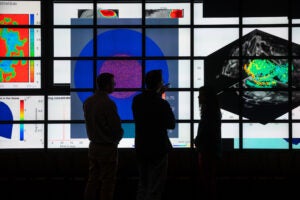AUSTIN, Texas—The University of Texas at Austin’s 2004-05 Tuition Policy Committee has recommended adoption of a flat rate tuition structure for all undergraduate students for academic year 2005-06 and proposed that tuition and fees for all full-load students (students taking 15 semester credit hours) be increased by 4.75 percent over the amount charged in 2004-05 to full-load students.
The committee, composed of students, faculty members and administrators appointed by Larry R. Faulkner, president of The University of Texas at Austin, presented the recommendations to the president Tuesday, Nov. 16. The committee will hold two public forums—on Nov. 19 and 30—to receive comment from members of the university community. Faulkner will observe the forums before developing his proposal to be sent to Chancellor Mark Yudof at the University of Texas System. The University of Texas Board of Regents is scheduled to review tuition policy proposals at its February 2005 meeting.
An online copy of the committee’s recommendations [PDF, download Adobe reader] is available here and on the Tuition Policy Committee’s Web site.
The committee presented recommendations for academic year 2005-06 in response to Faulkner’s request for a tuition policy that should “sustain and improve the quality of education and research at the university, encourage students to progress efficiently through the university, create greater transparency in pricing and greater accountability to students and the public, maintain accessibility to the university and generate sufficient revenue to help meet the financial needs of the university.”
Because of the significant contribution made by students in 2004-05, the committee recommended that the total tuition and fee increases paid by a full-load student be limited to 4.75 percent for 2005-06. The recommendations would generate about $20.7 million in additional revenue but the amount would fall short of the additional $53.7 million in new revenue needed for academic year 2005-06 to cover all expenses for identified essential university needs, the committee said. The $53.7 million projection includes a decline in enrollment and assumes no change in state-appropriated funds. The committee said additional revenue from the state is necessary for essential needs such as reduction of the student/faculty ratio, new academic initiatives, competitive salaries for faculty and staff, academic infrastructure capital projects, and repair and renovation of the university physical plant.
Of the $20.7 million in additional revenue that would be generated under the committee’s proposal, about $4.2 million would be set aside for financial aid and the required contribution to the B-On-Time loan repayment program. This would leave about $16.5 million to address essential university needs.
“Clearly, additional revenues are needed to meet the challenge of maintaining and enhancing excellence within the university,” the committee said. “The committee fully understands that by recommending this limited increase for 2005-06, it is deferring decisions necessary to address the critical needs of the university.”
The committee also recommended a continuation of need-based financial aid. For an undergraduate Texas resident with a family income of $40,000 or below, for example, financial aid would pay 100 percent of the proposed increase. Financial aid would cover 75 percent if the income were $40,001 to $60,000, and 50 percent if the income were $60,001 to $80,000. For independent undergraduate students and graduate students, the grants cover 50 percent of the proposed increase. The proposed plan includes a 24.5 percent financial aid set-aside of total new designated tuition income to be provided in 2005-06 from the tuition approved by the Board of Regents last year and the proposed 4.75 percent tuition increase for 2005-06. The total set-aside for financial aid amounts to about $27.2 million or about $4.2 million more than in 2004-05.
The 2004-05 Tuition Policy Committee is co-chaired by Sheldon Ekland-Olson, executive vice president and provost, and Kevin P. Hegarty, vice president and chief financial officer for the university. The voting members also include Brent B. Chaney, president of Student Government; Tse-Han “Amy” Fang, student representative at large; Paul A. Navratil, representative for the Graduate Student Assembly: Bruce P. Palka, chair of the Faculty Advisory Committee on Budgets; Mary Ann Rankin, dean of the College of Natural Sciences; Victoria E. Rodriguez, vice provost and dean of graduate studies; and Patrick Nicholas Staha, representative of the Senate of College Councils. Advisory members are Stephen Monti, executive vice provost, and Mary Knight, associate vice president and budget director.
The committee’s recommendation of a flat rate tuition structure for all undergraduates was influenced by the success of a pilot project, now in its third year, using a flat rate tuition structure in the College of Liberal Arts and College of Natural Sciences. The committee said the flat rate structure encourages undergraduate students to increase their course loads and reduce their time to graduation. Reducing the time to graduation, the committee said, reduces the total education costs for students and their families and also allows for increased access to the university.
“In addition, the simplified nature of flat rate charges should help students, families and the public better understand the total cost of attending the university,” the committee said.
The $0.85 per credit hour fee voted by the students for the construction of the new Gregory Gym Aquatics Center beginning in 2005-06 is in addition to the 4.75 percent increase. For undergraduate students, this new fee will be incorporated into the flat rate structure.
Under the proposed flat rate structure, full-load resident undergraduate students would be charged according to their field of study. The proposed charges would be as follows:
| College |
2004-2005 Total Semester Charge*
|
2005-06 Total Flat Rate Semester Charge*
|
Semester Increase
|
|
| RESIDENT | Statutory Tuition | Designated Tuition | ||
| Architecture | $3,423 | $3,585 | $30 | $132 |
| Business | $3,728 | $3,904 | $30 | $146 |
| Communication | $3,626 | $3,797 | $30 | $141 |
| Education | $3,440 | $3,603 | $30 | $133 |
| Engineering | $3,856 | $4,039 | $30 | $153 |
| Fine Arts | $3,725 | $3,901 | $30 | $146 |
| Liberal Arts | $3,331 | $3,488 | $30 | $127 |
| Natural Sciences | $3,483 | $3,648 | $30 | $135 |
| Nursing | $3,627 | $3,798 | $30 | $141 |
| Pharmacy (undergraduate) | $4,540 | $4,755 | $30 | $185 |
| Social Work | $3,461 | $3,624 | $30 | $133 |
| *Adjusted to include the student approved Gregory Aquatics Center fee to permit proper comparison of the year-to-year increase recommended by the Tuition Advisory Committee. | ||||
Part-time students taking between eight and 11 semester credit hours will pay a flat rate of 80 percent of the full-load rate, while those taking between one and seven semester credit hours will be charged a prorated amount based on the number of hours they take.
The committee recommended that graduate student charges maintain the current per semester credit hour charge structure with the intent to explore a graduate flat rate tuition strategy for academic year 2006-07 and beyond.
Another recommendation was that student advice be sought by each college or school on all flat rate tuition changes and related budget allocations recommended in the future. When establishing mechanisms to secure this advice, colleges and schools are encouraged to consult the resolutions presented to the committee by student representatives.
For more information contact: Don Hale or Robert D. Meckel, Office of Public Affairs, 512-471-3151.



